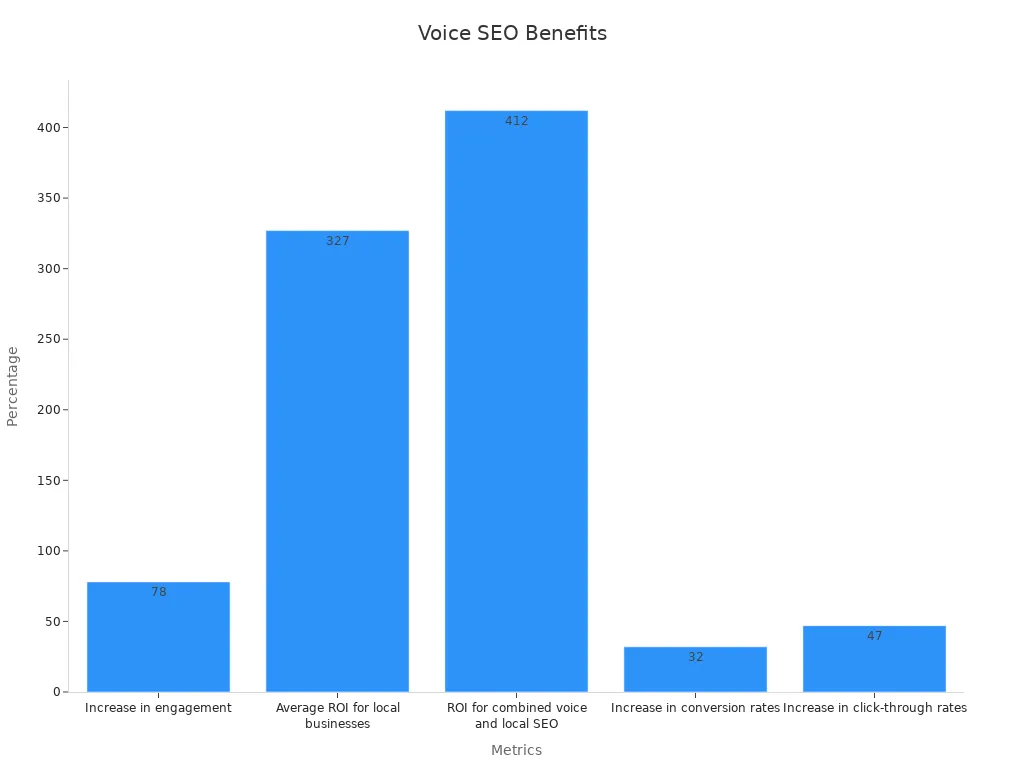Step-by-Step Guide to Keyword Research for SEO in 2025

Keyword research is key to good SEO plans in 2025. People’s search habits are changing fast. Over 80% of searches in the U.S. use 1-3 words. Tools like voice search and AI are changing how we search. This shows why knowing what people want is so important. You need to make content that helps answer their questions. Semantic search looks at meaning, not just exact words. So, it’s important to group content by main topics. If you learn these changes, your content will rank higher and reach the right people.
Key Takeaways
Finding the right keywords is important for good SEO. It shows what people search for and helps you make useful content.
Look for long-tail keywords. These are longer phrases that bring specific visitors and often lead to more sales or actions.
Use tools to check search numbers, competition, and what users want. This helps you pick the best words for your content.
Update your keyword plan often. Trends and what people like change, so new keywords keep your content fresh and interesting.
Check what your competitors are doing. Their keywords can help you find new ideas for your own content.
Understanding Keyword Research
What is keyword research?
Keyword research means finding words people often search online. These words show what people want and how they ask questions. Using these keywords helps you make content that matches their needs. This can make your website easier to find.
It’s not just about picking popular words. You also check how hard it is to rank for them and if they’re worth using. Longer keywords, called long-tail keywords, usually get more clicks. Studies say search phrases with 10-15 words get 1.76 times more clicks than short ones.
Keyword research helps you make content your audience likes. It makes sure your site shows up in searches that matter. This brings more visitors and makes your brand more visible.
Why is keyword research important for SEO?
Keyword research is very important for SEO. It shows why people search, like finding answers, shopping, or comparing options. For example, 52% of Google searches are for information, meaning users want to learn something.
Using the right keywords helps your content match what people want. Websites with good keywords in their URLs get 45% more clicks than those without. Adding keywords smartly can improve your site’s success.
Keyword research also helps you focus on the best words. Not all keywords are useful. About 94% of keywords are searched less than 10 times a month. Picking the right ones saves time and effort.
Adding keyword research to your SEO plan helps your content reach the right people. It boosts engagement and brings better results.
Step-by-Step Process for Effective Keyword Research
Brainstorming Topics and Seed Keywords
The first step is to think of topics and seed keywords. Start by asking what questions your audience might have. For instance, if you own a motorcycle repair shop, people might search for "motorcycle repair manuals" or "used motorcycle parts." These are better seed keywords than a general term like "motorcycle."
Here’s how to come up with ideas:
Write down main topics about your business.
Learn how your audience talks and what they need.
List seed keywords without worrying about popularity or difficulty.
Check competitors’ keywords for more ideas.
Use keyword tools to confirm your choices.
Pick keywords based on how useful and competitive they are.
A strong list of seed keywords is key to good research. One example showed that improving a keyword list helped a business triple its income and grow website traffic by 300%.
Using Keyword Research Tools
Keyword tools make finding good keywords easier. These tools show data like search numbers, competition, and related words. For example, platforms like Google Ads, Semrush, and Google Search Console help you gather keyword info.
Here’s how these tools can help your strategy:
CTR (Click-Through Rate): Tools find keywords that get clicks. A high CTR means your keywords and descriptions work well.
Impressions: They show how often your content appears in searches, showing keyword visibility.
Conversions: Tools track which keywords lead to actions like purchases, so you can focus on the best ones.
Metric | What It Means |
|---|---|
CTR | Shows how often people click on your content. |
Impressions | Tracks how visible your keywords are in search results. |
Conversions | Measures how well your keywords lead to actions like sign-ups or sales. |
Using these tools makes your keyword research smarter and goal-focused.
Analyzing Competitors’ Strategies
Looking at competitors helps improve your keyword plan. By studying them, you can find gaps in your strategy and new chances to do better.
Here’s how to study competitors:
Look at the keywords your competitors use.
Find gaps in their plan and focus on unused keywords.
Create content for topics where competitors rank high.
Use tools like SearchAtlas to track competitors’ keyword updates.
For example, competitor alerts can tell you when their strategy changes. This helps you adjust quickly. This method not only improves your keyword research but also boosts your SEO results.
Understanding search intent
Knowing why people search helps with keyword research. Search intent means the reason behind what someone types online. When users search, they want something specific. Your goal is to figure it out and make content they need.
There are three main kinds of search intent: informational, navigational, and transactional. Informational intent is when someone wants to learn something. For example, they might search "how to fix a flat tire." Navigational intent is when they look for a brand or website, like "Nike official store." Transactional intent happens when they want to act, like buying or signing up. A search like "buy running shoes online" shows transactional intent.
To match your content with search intent, study the keywords you choose. Check the top search results for those words. Do they teach, guide to a brand, or sell something? This shows what users expect. Making content that fits their intent helps you rank higher and connect with them.
Selecting and prioritizing keywords
Choosing and ranking keywords is key for a good strategy. Not all keywords are equally useful. Some bring many visitors but few actions. Others bring fewer visitors but more sales. Focus on keywords that match your goals.
To rank keywords, check things like search volume, difficulty, competition, and conversion rate. These help you see each keyword’s value. For example, a keyword with many searches but low competition is a good chance. A keyword with high competition may take more work to rank.
Measure | What It Means |
|---|---|
Search Volume | Shows how often people search a keyword, helping find traffic sources. |
Keyword Difficulty | Tells how hard it is to rank for a keyword, helping pick easier ones. |
Competition | Shows how many advertisers use a keyword, hinting at its value. |
Conversion Rate | Measures how well a keyword leads to actions, helping focus on the best ones. |
After gathering this data, group keywords by their intent and value. Use a mix of popular and long-tail keywords. Long-tail keywords are less competitive and convert better. For instance, instead of "shoes," try "best running shoes for beginners." This way, your keyword plan works smarter and better.
Advanced Keyword Research Strategies for 2025
Using semantic keywords
Semantic keywords help match your content to what users need. Instead of exact words, focus on the meaning of searches. This makes your SEO better by creating helpful content. For example, an online store increased traffic by 30% after improving product descriptions with semantic keywords.
Tools like the SearchAtlas Keyword Researcher Tool study user intent and context. They help you make content that connects with your audience. This approach boosts engagement and shows search engines your content is valuable. Using semantic keywords can improve visibility and increase conversions.
Preparing for voice search
Voice search is now a big part of SEO plans. People use natural phrases when talking to devices like Alexa or Siri. To prepare for voice search, use long-tail keywords and casual language. For example, instead of "best pizza," someone might say, "Where’s the best pizza near me?"
Voice search helps local businesses too. Studies show combining voice and local SEO gives a 412% return on investment. It also raises engagement by 78% and conversions by 32%.

By optimizing for voice search, you can connect with users naturally and improve your site’s results.
Using AI tools
AI tools are changing how we do keyword research. They study large data sets to suggest smarter keywords. Tools like SearchAtlas use machine learning to update keyword lists based on trends. They also find niche keywords and social media topics to better engage users.
For example, a small online store used SearchAtlas to add market-specific terms. This boosted their organic traffic. Similarly, a blog improved rankings by using AI keyword suggestions.
AI tools also help set realistic SEO goals by matching keywords to your site’s strength. They even consider cultural differences for global SEO. Adding AI to your SEO plan saves time and gets better results.
Targeting long-tail keywords
Using long-tail keywords can greatly help your SEO plan. These are longer, detailed phrases people search with clear goals. For example, instead of "laptops," someone might search "best laptops for students under $500." By focusing on these specific searches, you attract users ready to decide.
Long-tail keywords have many benefits. They make up 40% of search traffic and 70% of page views. Even though fewer people search them, they match user needs better. This leads to more purchases or sign-ups. Visitors from long-tail keywords are more likely to buy something. This makes them very useful for niche SEO success.
To use long-tail keywords well, learn what your audience needs. Think about their problems or questions they might ask. Use tools like Google Keyword Planner or Semrush to find good phrases. Pick keywords with low competition but high relevance to your content.
Add long-tail keywords naturally into your content. Don’t overuse them or force them in. Place them in headings, subheadings, and paragraphs where they fit smoothly. This helps your SEO and gives readers helpful, clear information.
By using long-tail keywords, your site can rank higher and attract interested visitors. These keywords connect you with users ready to act, making them a key part of your SEO plan.
Best Tools for Keyword Research

Free tools for keyword research
Free tools are great for starting keyword research without spending money. They give useful details about search trends and user habits. Here are some popular free tools:
Keyword Surfer: Suggests keywords directly in your browser.
Google Keyword Planner: Shares search volume and keyword ideas.
QuestionDB: Finds questions people ask about your topic.
Google Search Console: Tracks your site’s performance and top keywords.
Answer The Public: Shows questions and phrases users search online.
WordStream's Free Keyword Tool: Suggests keywords based on your industry and location.
These tools are simple to use and help you start building your SEO plan.
Paid tools for keyword research
Paid tools have advanced features to improve your keyword research. They give deeper insights, competitor data, and real-time updates. Here’s a comparison of some top paid tools:
Tool Name | Key Features | Benefits for Investment |
|---|---|---|
Ahrefs | Detailed keyword data, competitor analysis, market trends | |
SEMrush | Wide keyword analytics, competitor tracking | Improves online visibility and targeting accuracy |
Moz | Keyword ideas, search engine result analysis | Helps with better keyword choices |
KWFinder | Finds long-tail keywords with low competition | Increases organic search rankings |
Jaaxy | Finds profitable keywords, tracks rankings | Perfect for affiliate marketers |
Using these tools can save time and give better SEO results with helpful data.
Features to consider in keyword tools
When picking a keyword tool, look for features that match your goals. Some features are key to improving your SEO:
Feature | Benefit |
|---|---|
AI-driven insights | Gives smart data for better decisions |
Competitor analysis | Finds gaps and new chances in the market |
Keyword difficulty scores | Helps pick easier keywords to rank higher |
Real-time optimization capabilities | Allows quick changes using current data |
Predictive analytics | Predicts trends for future planning |
Automated keyword clustering | Organizes keywords quickly and easily |
Real-time SERP analysis | Shows current search results for fast updates |
Understanding user intent | Makes content more relevant to users |
Keyword prioritization | Focuses on the best keywords for success |
Choosing tools with these features helps you stay ahead in SEO competition.
Monitoring and Improving Keyword Performance
Tracking keyword rankings
Tracking keyword rankings shows how well your SEO is working. It tells you where your site ranks for specific keywords. This ranking affects how many people see your content. Tools like Google Search Console and Ahrefs can help track this data.
Here’s why tracking rankings is helpful:
Climbing the Search Engine Ladder: It shows where to improve for better visibility.
Crafting Content that Converts: Popular keywords help you make content people like.
Learning From the Best (and Beating Them): Studying competitors shows gaps you can fill.
Staying Ahead of the Curve: Trends in keyword data help you adjust quickly.
Measuring Your Success (and Making Money): Rankings show what works and where to invest.
By checking rankings often, you can improve your plan and get better results.
Updating content for relevance
Updating your content keeps it helpful and easy to find. Keywords can become outdated, and user needs change over time. Regular updates keep your content fresh and engaging.
Here are key signs your content needs updates:
Why It Matters | |
|---|---|
Organic Traffic | Less traffic means you may need better keywords. |
Bounce Rate | High bounce rates show users aren’t finding what they need. |
Average Session Duration | Short visits mean your content might need videos or images. |
Conversion Rate | Low conversions mean your CTAs or content need work. |
Backlinks & Social Shares | Few shares or links mean your content needs more value. |
Updating based on these signs helps your site stay useful and perform well.
Exploring new keyword opportunities
Finding new keywords helps you keep up with changes. Predictive tools can show future trends to guide your strategy. Studying customer behavior shows how people interact with your content.
Here’s how to find new keywords:
Use predictive tools to update your keyword list.
Study customer actions to see what they like.
Divide your audience into groups to find new keyword ideas.
By finding fresh keywords, you can stay ahead and connect better with your audience.
Keyword research is still important for SEO in 2025. It helps you learn what users want, make useful content, and boost your site’s ranking. By thinking of seed keywords, studying competitors, and using tools like AI, you can create a solid plan. Key metrics like search volume, organic traffic, and user engagement show your progress:
Metric | What It Shows |
|---|---|
Search Volume | How often people search a keyword, helping pick good topics. |
Organic Traffic | Measures how well your SEO works by tracking unpaid visits. |
User Engagement Metrics | Tracks how users interact with your content, showing what works best. |
Start your keyword research now. Follow trends like voice search and semantic keywords to stay ahead.
FAQ
What is the difference between short-tail and long-tail keywords?
Short-tail keywords are general terms with many searches, like "shoes." Long-tail keywords are detailed phrases, such as "best running shoes for beginners." Long-tail keywords bring specific visitors and often lead to more sales.
Tip: Use long-tail keywords to reach users ready to decide.
How often should you update your keyword strategy?
You should check your keyword plan every 3-6 months. Trends, user habits, and search engine rules change often. Regular updates keep your content useful and competitive.
Note: Use tools like Google Trends to track keyword changes.
Can voice search keywords improve local SEO?
Yes, voice search keywords often include location phrases like "near me." Optimizing for these helps local businesses show up in voice searches, boosting visibility and visits.
Example: Add phrases like "best pizza near me" to improve local SEO.
Are free keyword tools effective for beginners?
Free tools like Google Keyword Planner and Answer The Public are great for beginners. They give simple details about search trends and user questions. These tools help you start building a strong keyword list without spending money.
Emoji Insight: 🆓 Free tools are perfect for learning keyword basics!
How do you measure the success of your keyword strategy?
Track things like search rankings, organic traffic, and conversion rates. These show how well your keywords work and if they meet your goals.
Metric | What It Shows |
|---|---|
Search Rankings | How visible your site is in searches |
Organic Traffic | Visits to your site without ads |
Conversion Rates | Actions visitors take on your site |
Pro Tip: Use tools like Ahrefs or SEMrush to track these metrics easily.
See Also
Unlocking LSI Keywords For Effective SEO Strategies
Essential SEO Strategies For New Business Startups
14-Step Process For Conducting A Thorough SEO Audit
A Detailed Introduction To Search Engine Optimization Techniques

